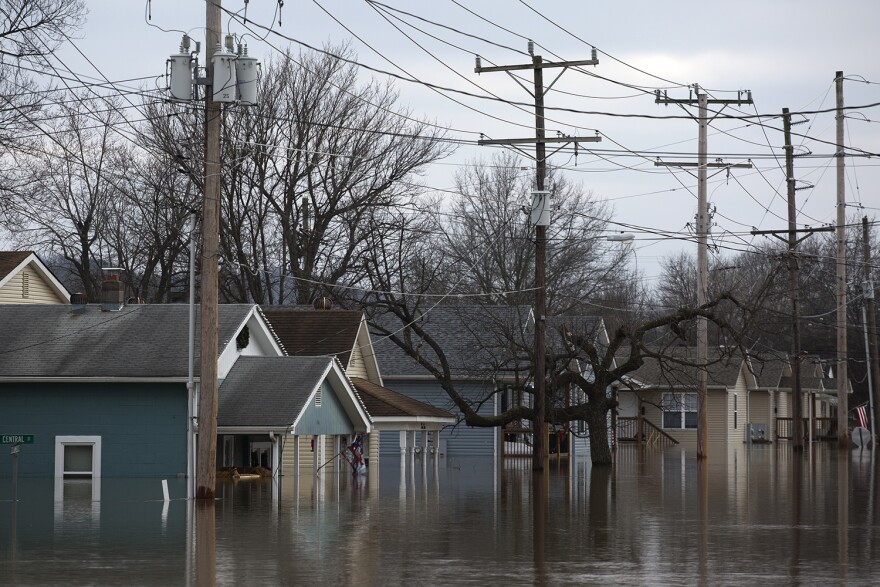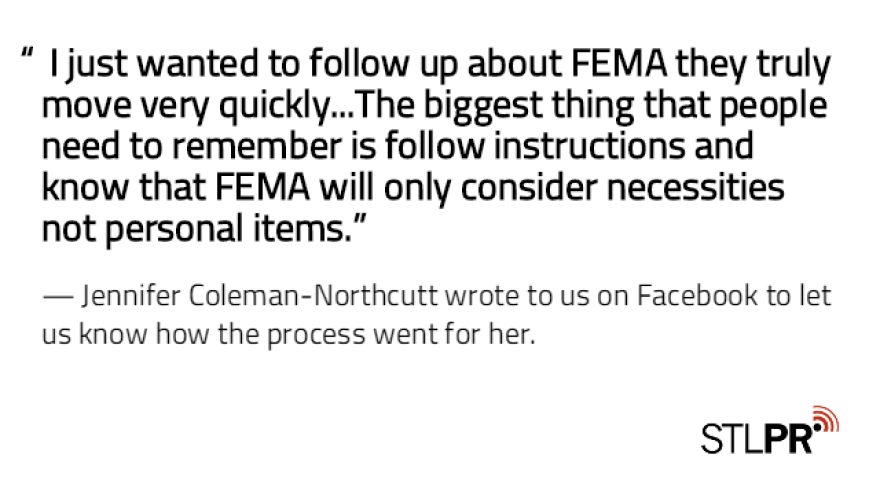Updated 10:45 a.m., Jan. 24 with information from FEMA—Hundreds of thousands of federal dollars are available to Missourians whose homes were damaged in flooding between Dec. 23 and Jan. 9, now that President Barrack Obama has declared 33 counties a major disaster area.
But figuring out whether you qualify for aid can be confusing. So we enlisted the help of Jono Anzalone, who oversees American Red Cross disaster relief for Missouri, to create a FAQ for FEMA applications.
Should I apply?
The short answer is yes. If you live or own property in one of the 33 counties covered by the president’s major disaster declaration and your home or business was damaged, then you should apply.
Even if you have flood insurance, it might not be enough to cover the damage. And according to John Mills, a regional spokesman for FEMA, having flood insurance is never a requirement for qualifying for aid from his agency.
So apply even if you live in an area prone to flooding and don’t think you have insurance. And apply even if you think your insurance will cover the damage.
“I tell people all the time: if you think you have insurance, if you think you’re in a flood plain, if you’re a renter, not a homeowner—register anyway because that is the most critical thing that an individual can do. And FEMA doesn’t mind it,” Anzalone said.
How much aid will I get?
Depending on the amount of damage and the value of the property, FEMA could award a renter or homeowner as much as $33,000. But most people will receive less than that.

“In general people don’t get the maximum, but it will vary depending on the damage,” Mill said, adding that depending on circumstances renters can get up to 18 months of assistance.
“It’s decided on a case by case basis,” Mill said. “It’s not unusual if a whole neighborhood is destroyed for the entire neighborhood to get the max.”
The Red Cross’s Anzalone said the average major disaster recipient gets less than $5,000 from FEMA.
“We try to temper expectations,” Anzalone said. “There are only a handful of people in big disasters that receive (what we in the humanitarian aid field call) the max grant.”
Renter’s assistance is included in the FEMA grants.
People who own damaged property can also receive low-interest loans worth hundreds of thousands of dollars from the Small Business Administration. Despite the organization’s name, homeowners can also qualify for the loans.
“People get confused when they get a small business application packet in the mail post-disaster. They think I’m not a business. I don’t need this. But that is by far the lion’s share of disaster-recovery funding that comes under a FEMA declaration,” Anzalone said.
According to Mills, the Small Business Administration now contacts individuals who may qualify for their loans instead of sending application packets.
How long will it take to get it?
Best case scenario, it could take as little as 72 hours from the time you apply until the time the check from FEMA is deposited in your bank account.
“FEMA can sometimes tell within minutes whether you qualify,” Anzalone said. "I’ve seen them issue inspections in less than 72 hours in disasters of this size.”

But the amount of time varies from disaster to disaster, and Mills said the actual time between applying and receiving a check could be longer.
Anzalone said it’s important to follow up with paperwork that comes in the mail and check in with your non-profit disaster relief case worker to help you navigate your options. Applying for disaster relief through FEMA now triggers a host of other federal programs that could give you aid, thanks to a post-Katrina overhaul mandated by Congress.
The application is now a question and answer process, both over the phone and online. Those answers trigger possible eligibility for other federal programs, such as rural housing aid through the U.S. Department of Agriculture.
“That system has just gotten so much better,” Anzalone said.
What are my odds?
While it’s difficult to guess how many people qualify, Anzalone said a lot of people are under-insured for floods.
“I know from our damage assessment, when we looked at (all 33 counties) we saw just over 2700 homes that had damage. Of those, 1300 are what we consider major to destroyed,” Anzalone said. “We know that there is a high likelihood in flood circumstances that people are either not insured or under-insured, and that’s a lot different than a tornado. We saw communities that had estimates of uninsured of upwards of 70 percent.”

What should I do if my application is denied?
Check back in with FEMA and read your denial letter carefully. You may just need to provide the agency with more information.
“Sometimes it’s one missing piece of documentation, such as proof of ownership,” Mills said.
According to Mills, you can also ask for an additional FEMA inspection if you think inspectors missed some damage the first time.
You can also meet with a case manager at a non-profit disaster relief agency like Catholic Charities, Lutheran Services or the American Red Cross.

"A good, seasoned disaster case manager can look at the paperwork that the client received, (and) question whether or not it truly should have been denied because they know the inside out of FEMA," said Anzalone. "Most importantly, if they were denied (the nonprofit case manager knows) what other resources are available.”
“There are so many pockets of money out there that a client would be utterly confused if they tried to navigate the system on their own. Go to that agency that you trust, go to that case manager and let them walk you through the options that are available,” he added.
To apply for federal aid from FEMA, call 1-800-621-FEMA (3362) or go to www.DisasterAssistance.gov. The deadline to apply is March 21.
Follow Camille Phillips on Twitter: @cmpcamille.





